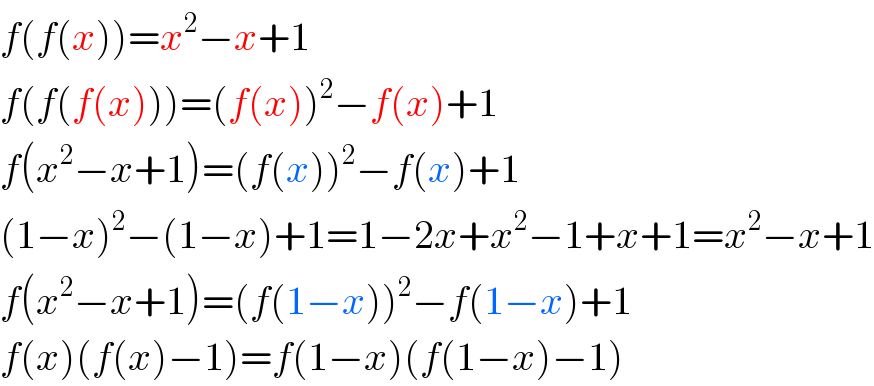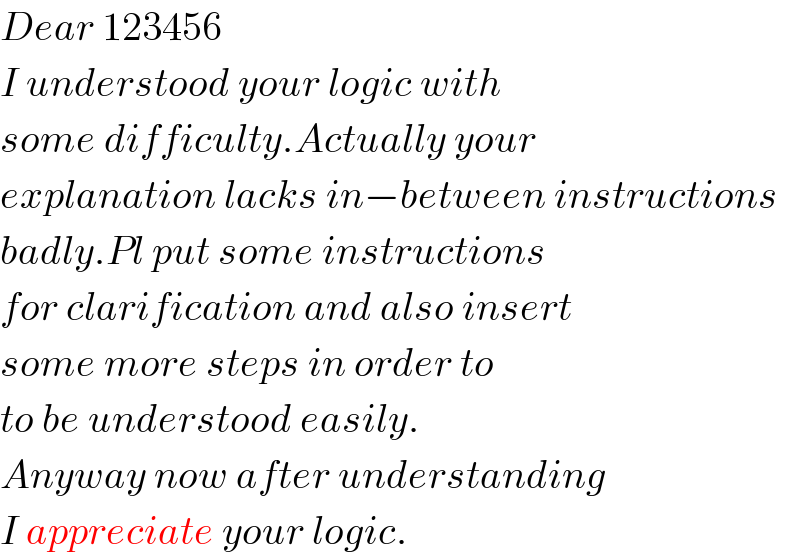
Question Number 1229 by Rasheed Soomro last updated on 16/Jul/15

$${f}\left(\:{f}\left({x}\right)\:\right)={x}^{\mathrm{2}} −{x}+\mathrm{1} \\ $$$${f}\left({x}\right)=? \\ $$$$\left({Modification}\:{of}\:{Q}\:\mathrm{1147}\right) \\ $$
Commented by 123456 last updated on 17/Jul/15

$${f}\left({f}\left({x}\right)\right)={x}^{\mathrm{2}} −{x}+\mathrm{1} \\ $$$${f}\left({f}\left({f}\left({x}\right)\right)\right)=\left({f}\left({x}\right)\right)^{\mathrm{2}} −{f}\left({x}\right)+\mathrm{1} \\ $$$${f}\left({x}^{\mathrm{2}} −{x}+\mathrm{1}\right)=\left({f}\left({x}\right)\right)^{\mathrm{2}} −{f}\left({x}\right)+\mathrm{1} \\ $$$$\left(\mathrm{1}−{x}\right)^{\mathrm{2}} −\left(\mathrm{1}−{x}\right)+\mathrm{1}=\mathrm{1}−\mathrm{2}{x}+{x}^{\mathrm{2}} −\mathrm{1}+{x}+\mathrm{1}={x}^{\mathrm{2}} −{x}+\mathrm{1} \\ $$$${f}\left({x}^{\mathrm{2}} −{x}+\mathrm{1}\right)=\left({f}\left(\mathrm{1}−{x}\right)\right)^{\mathrm{2}} −{f}\left(\mathrm{1}−{x}\right)+\mathrm{1} \\ $$$${f}\left({x}\right)\left({f}\left({x}\right)−\mathrm{1}\right)={f}\left(\mathrm{1}−{x}\right)\left({f}\left(\mathrm{1}−{x}\right)−\mathrm{1}\right) \\ $$
Commented by Rasheed Ahmad last updated on 18/Jul/15

$${Dear}\:\mathrm{123456} \\ $$$${I}\:{understood}\:{your}\:{logic}\:{with}\: \\ $$$${some}\:{difficulty}.{Actually}\:{your}\: \\ $$$${explanation}\:{lacks}\:{in}−{between}\:{instructions} \\ $$$${badly}.{Pl}\:{put}\:{some}\:{instructions}\: \\ $$$${for}\:{clarification}\:{and}\:{also}\:{insert}\: \\ $$$${some}\:{more}\:{steps}\:{in}\:{order}\:{to}\: \\ $$$${to}\:{be}\:{understood}\:{easily}. \\ $$$${Anyway}\:{now}\:{after}\:{understanding} \\ $$$${I}\:{appreciate}\:{your}\:{logic}. \\ $$
Commented by Rasheed Ahmad last updated on 17/Jul/15
![Very good rule and very nice feature you have discovered: Rule: d(f•f)= [d(f)]^2 feature: f( f(x) )=f( f(1−x) ) Appreciation for you!](Q1249.png)
$${Very}\:{good}\:{rule}\:{and}\:{very}\:{nice}\: \\ $$$${feature}\:{you}\:{have}\:{discovered}: \\ $$$${Rule}:\:{d}\left({f}\bullet{f}\right)=\:\left[{d}\left({f}\right)\right]^{\mathrm{2}} \\ $$$${feature}:\:\:{f}\left(\:{f}\left({x}\right)\:\right)={f}\left(\:{f}\left(\mathrm{1}−{x}\right)\:\right) \\ $$$${Appreciation}\:{for}\:{you}! \\ $$
Commented by Rasheed Ahmad last updated on 17/Jul/15

$${It}\:{can}\:{be}\:{proved}\:{that}\:{f}\left({x}\right)\:{is}\:{not}\:{a} \\ $$$${polynomial}. \\ $$
Commented by 123456 last updated on 17/Jul/15
![yes, because if d(f) is the degree of f then the degree of f•f is d(f•f)=[d(f)]^2 then [d(f)]^2 =2⇒d(f)=(√2) wich is impossible however its have some symetry, you easy can see that f(f(x))=f(f(1−x))](Q1248.png)
$$\mathrm{yes},\:\mathrm{because}\:\mathrm{if}\:\mathrm{d}\left({f}\right)\:\mathrm{is}\:\mathrm{the}\:\mathrm{degree}\:\mathrm{of}\:{f} \\ $$$$\mathrm{then}\:\mathrm{the}\:\mathrm{degree}\:\mathrm{of}\:{f}\bullet{f}\:\mathrm{is}\:\mathrm{d}\left({f}\bullet{f}\right)=\left[\mathrm{d}\left({f}\right)\right]^{\mathrm{2}} \\ $$$$\mathrm{then} \\ $$$$\left[\mathrm{d}\left({f}\right)\right]^{\mathrm{2}} =\mathrm{2}\Rightarrow\mathrm{d}\left({f}\right)=\sqrt{\mathrm{2}} \\ $$$$\mathrm{wich}\:\mathrm{is}\:\mathrm{impossible} \\ $$$$\mathrm{however}\:\mathrm{its}\:\mathrm{have}\:\mathrm{some}\:\mathrm{symetry},\:\mathrm{you}\:\mathrm{easy} \\ $$$$\mathrm{can}\:\mathrm{see}\:\mathrm{that} \\ $$$${f}\left({f}\left({x}\right)\right)={f}\left({f}\left(\mathrm{1}−{x}\right)\right) \\ $$
Commented by 123456 last updated on 19/Jul/15

$${f}\left(\mathrm{0}\right)=\mathrm{1}\left(\mathrm{from}\:\mathrm{Q1147}\right) \\ $$$${f}\left(\mathrm{1}\right)=\mathrm{1}\left(\mathrm{from}\:\mathrm{Q1147}\right) \\ $$$$\mathrm{claim}\:\mathrm{1}:{f}\left({x}\right)=\mathrm{1}\:\mathrm{only}\:\mathrm{if}\:{x}=\mathrm{0}\:\mathrm{or}\:{x}=\mathrm{1} \\ $$$$\mathrm{proof}: \\ $$$$\mathrm{suppose}\:\mathrm{there}\:\mathrm{are}\:\mathrm{some}\:{x}\notin\left\{\mathrm{0},\mathrm{1}\right\}\:\mathrm{such}\:\mathrm{that}\:{f}\left({x}\right)=\mathrm{1},\:\mathrm{then} \\ $$$${f}\left({f}\left({x}\right)\right)={x}^{\mathrm{2}} −{x}+\mathrm{1} \\ $$$${f}\left(\mathrm{1}\right)={x}^{\mathrm{2}} −{x}+\mathrm{1} \\ $$$$\mathrm{1}={x}^{\mathrm{2}} −{x}+\mathrm{1} \\ $$$${x}^{\mathrm{2}} −{x}=\mathrm{0} \\ $$$${x}\left({x}−\mathrm{1}\right)=\mathrm{0} \\ $$$${x}=\mathrm{0}\vee{x}=\mathrm{1} \\ $$$$\mathrm{contradiction}\:\mathrm{with}\:\mathrm{the}\:\mathrm{fact}\:\mathrm{that}\:{x}\notin\left\{\mathrm{0},\mathrm{1}\right\} \\ $$$$\mathrm{claim}\:\mathrm{2}:{f}\left(\mathrm{0}\right)=\mathrm{1} \\ $$$$\mathrm{suppose}\:\mathrm{that}\:{f}\left(\mathrm{0}\right)={a}\:\mathrm{with}\:{a}\notin\left\{\mathrm{0},\mathrm{1}\right\} \\ $$$${f}\left({f}\left({x}\right)\right)={x}^{\mathrm{2}} −{x}+\mathrm{1} \\ $$$${f}\left({f}\left(\mathrm{0}\right)\right)=\mathrm{1}\:\:\:\:\:\:\:\:\:\:\:\:\:\:\:\:\:\:\:\:\:\:\left({x}=\mathrm{0}\right) \\ $$$${f}\left({a}\right)=\mathrm{1} \\ $$$$\mathrm{contradction}\:\mathrm{with}\:\mathrm{claim}\:\mathrm{1}. \\ $$$$\mathrm{but}\:{a}\neq\mathrm{0},\:\mathrm{because}\:\mathrm{if}\:{a}=\mathrm{0},\:\mathrm{then} \\ $$$${f}\left({f}\left(\mathrm{0}\right)\right)=\mathrm{1} \\ $$$${f}\left(\mathrm{0}\right)=\mathrm{1} \\ $$$$\mathrm{contradiction}\:\mathrm{with}\:{f}\left(\mathrm{0}\right)={a}=\mathrm{0} \\ $$$$\mathrm{claim}\:\mathrm{3}:\nexists{x},{f}\left({x}\right)=\mathrm{0} \\ $$$$\mathrm{suppose}\:\mathrm{that}\:\mathrm{there}\:\mathrm{is}\:\mathrm{some}\:{x}\:\mathrm{that}\:{f}\left({x}\right)=\mathrm{0},\:\mathrm{then} \\ $$$${f}\left({f}\left({x}\right)\right)={x}^{\mathrm{2}} −{x}+\mathrm{1} \\ $$$${f}\left(\mathrm{0}\right)={x}^{\mathrm{2}} −{x}+\mathrm{1} \\ $$$$\mathrm{by}\:\mathrm{claim}\:\mathrm{2} \\ $$$$\mathrm{1}={x}^{\mathrm{2}} −{x}+\mathrm{1} \\ $$$${x}=\mathrm{0}\vee{x}=\mathrm{1} \\ $$$$\mathrm{contradction}\:\mathrm{with}\:{f}\left(\mathrm{0}\right)={f}\left(\mathrm{1}\right)=\mathrm{1} \\ $$$$\mathrm{claim}\:\mathrm{4}:{f}\left({x}\right)={x}\:\mathrm{only}\:\mathrm{for}\:{x}=\mathrm{1} \\ $$$$\mathrm{suppose}\:\mathrm{that}\:\mathrm{f}\left({x}\right)={x}\:\mathrm{for}\:\mathrm{some}\:{x}\neq\mathrm{1},\:\mathrm{then} \\ $$$${f}\left({f}\left({x}\right)\right)={x}^{\mathrm{2}} −{x}+\mathrm{1} \\ $$$${f}\left({x}\right)={x}^{\mathrm{2}} −{x}+\mathrm{1} \\ $$$${x}={x}^{\mathrm{2}} −{x}+\mathrm{1} \\ $$$${x}^{\mathrm{2}} −\mathrm{2}{x}+\mathrm{1}=\mathrm{0} \\ $$$$\left({x}−\mathrm{1}\right)^{\mathrm{2}} =\mathrm{0} \\ $$$${x}=\mathrm{1} \\ $$$$\mathrm{wich}\:\mathrm{contradict}\:\mathrm{the}\:\mathrm{fact}\:\mathrm{that}\:{x}\neq\mathrm{1} \\ $$$$−−−−−−−−−−−−− \\ $$$${x}^{\mathrm{2}} −{x}+\mathrm{1}=\mathrm{0} \\ $$$$\Delta=\left(−\mathrm{1}\right)^{\mathrm{2}} −\mathrm{4}\left(\mathrm{1}\right)\left(\mathrm{1}\right)=\mathrm{1}−\mathrm{4}=−\mathrm{3} \\ $$$${x}=\frac{−\left(−\mathrm{1}\right)\pm\sqrt{−\mathrm{3}}}{\mathrm{2}\left(\mathrm{1}\right)}=\frac{\mathrm{1}\pm{i}\sqrt{\mathrm{3}}}{\mathrm{2}}={e}^{\pm{i}\pi/\mathrm{3}} \\ $$$$−−−−−−−−−−−−−−−− \\ $$$${f}\left({f}\left({x}\right)\right)={x}^{\mathrm{2}} −{x}+\mathrm{1} \\ $$$${f}\left({x}\right)={y} \\ $$$${f}\left({y}\right)={x}^{\mathrm{2}} −{x}+\mathrm{1} \\ $$$${f}\left({f}\left({f}\left({x}\right)\right)\right)=\left({f}\left({x}\right)\right)^{\mathrm{2}} −{f}\left({x}\right)+\mathrm{1} \\ $$$${f}\left({f}\left({y}\right)\right)={y}^{\mathrm{2}} −{y}+\mathrm{1} \\ $$$${f}\left({y}\right)={z} \\ $$$${f}\left({z}\right)={y}^{\mathrm{2}} −{y}+\mathrm{1} \\ $$$$−−−−−−−−−−−−−−−− \\ $$$${f}\left({f}\left(\mathrm{1}/\mathrm{2}\right)\right)=\mathrm{3}/\mathrm{4} \\ $$$${f}\left(\mathrm{3}/\mathrm{4}\right)=\left({f}\left(\mathrm{1}/\mathrm{2}\right)\right)^{\mathrm{2}} −{f}\left(\mathrm{1}/\mathrm{2}\right)+\mathrm{1} \\ $$
